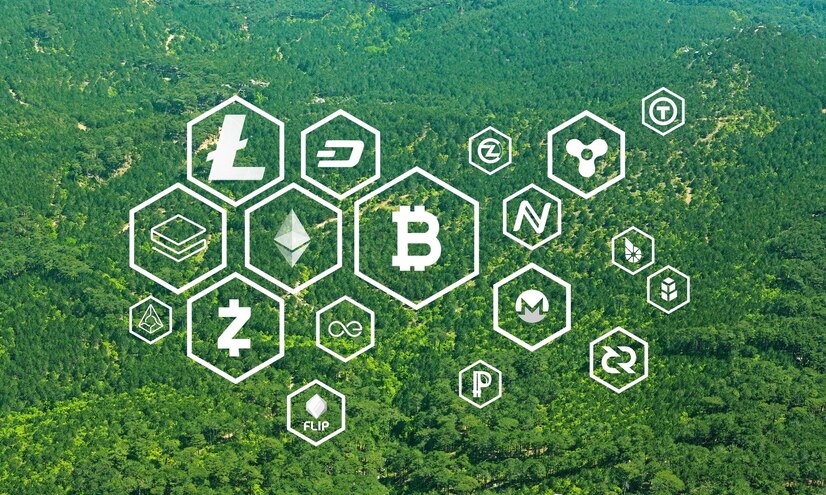
Introduction to Carbon Credits and Blockchain Integration
In recent years, the convergence of two powerful forces, carbon credits, and blockchain technology, has emerged as a promising synergy that holds immense potential for advancing sustainable development. Carbon credits, a key component of global efforts to mitigate climate change, represent a unit of measurement for reducing or offsetting greenhouse gas emissions. On the other hand, blockchain, a decentralized and transparent digital ledger technology, has gained widespread recognition for its ability to enhance accountability and efficiency across various industries.
Carbon credits play a crucial role in encouraging businesses and organizations to reduce their carbon footprint. These credits are earned when entities take measurable actions to reduce or remove greenhouse gas emissions from the atmosphere. Such actions could range from investing in renewable energy projects to implementing energy-efficient technologies. The integration of blockchain technology into the carbon credit ecosystem brings a new level of transparency and security to the entire process.
Blockchain’s decentralized ledger system provides a tamper-proof and auditable record of carbon credit transactions. This transparency addresses one of the longstanding challenges in the carbon credit market – ensuring the credibility and traceability of emission reduction efforts. By recording each step of the carbon credit lifecycle on a blockchain, from project initiation to credit issuance and trading, stakeholders can have confidence in the integrity of the environmental impact claims associated with each credit.
Moreover, the introduction of smart contracts within the blockchain framework further enhances the efficiency of carbon credit transactions. Smart contracts are self-executing agreements with the terms of the contract directly written into code. In the context of carbon credits, these contracts can automatically trigger the transfer of credits once predefined conditions are met. This automation reduces the need for intermediaries, streamlining the process and reducing the risk of errors or fraud.
The integration of blockchain and carbon credits not only addresses operational inefficiencies but also opens up new possibilities for global collaboration in the fight against climate change. The decentralized nature of blockchain allows for the creation of a secure and accessible platform that facilitates international cooperation on carbon credit initiatives. This collaborative approach is vital for achieving meaningful and widespread impact, considering the inherently global nature of environmental challenges.
As we delve deeper into the potential of combining carbon credits and blockchain technology, it becomes evident that this synergistic approach has the capacity to revolutionize how we perceive and address sustainable development. This blog explores the various facets of this integration, from the fundamental principles of carbon credits to the transformative impact of blockchain, and examines case studies and future prospects that showcase the promising trajectory of this dynamic collaboration.
Understanding Carbon Credits: A Key Element in Sustainable Development
To comprehend the significance of carbon credits in the realm of sustainable development, it is essential to first grasp the concept of carbon credits and their pivotal role in mitigating climate change. Carbon credits represent a unit of measurement for greenhouse gas emissions reduction or removal activities. As part of broader environmental strategies, carbon credits are instrumental in incentivizing businesses and organizations to adopt practices that contribute to a net decrease in their carbon footprint.
The underlying principle of carbon credits revolves around the idea of creating a market-based mechanism to reduce overall greenhouse gas emissions. This market functions by allowing entities that have successfully reduced their emissions below a predefined baseline to earn tradable credits. These credits can then be sold to organizations or individuals that find it challenging to meet their emission reduction targets independently. In essence, carbon credits create a pathway for the transfer of environmental benefits from those who have exceeded their reduction goals to those who may struggle to do so.
This system not only encourages innovation and the adoption of sustainable practices but also provides a financial incentive for entities to invest in projects that result in measurable emission reductions. Such projects could include renewable energy installations, reforestation efforts, energy efficiency initiatives, and more. By attaching a market value to carbon reductions, carbon credits transform environmental stewardship into an economically viable and scalable endeavor.
One of the primary advantages of carbon credits is their flexibility. The international nature of the carbon credit market enables organizations to participate in emissions reduction efforts globally, contributing to projects that offer the most effective and cost-efficient solutions. This flexibility promotes a collaborative approach to sustainability, fostering cooperation between developed and developing nations in the shared goal of mitigating climate change.
Furthermore, carbon credits play a critical role in achieving carbon neutrality. Organizations striving to offset their unavoidable emissions can invest in carbon credit projects equivalent to the amount of emissions they cannot eliminate. This balance between emissions and offsets is essential for businesses and governments alike as they work towards achieving net-zero carbon emissions and aligning with international climate goals.
In the broader context of sustainable development, carbon credit platform development contribute to the creation of a more environmentally conscious and responsible global community. They incentivize the adoption of cleaner technologies, support local communities through sustainable projects, and stimulate economic growth in the green sector. As the world faces increasing climate challenges, understanding and embracing the role of carbon credits becomes paramount in shaping a sustainable future that balances economic prosperity with environmental stewardship.
The Role of Blockchain Technology in Revolutionizing Sustainability
Blockchain technology has emerged as a transformative force with the potential to revolutionize sustainability efforts across various industries. At its core, blockchain is a decentralized and transparent ledger system that records transactions in a secure and tamper-resistant manner. This technology introduces several key elements that can significantly impact the way we approach and achieve sustainability goals.
- Transparency and Traceability: Blockchain’s decentralized nature ensures transparency by providing a shared and immutable ledger accessible to all participants in a network. This feature is particularly valuable in supply chain management, allowing stakeholders to trace the origin and journey of products. In the context of sustainability, this transparency helps verify the authenticity of eco-friendly claims, ensuring that products labeled as sustainable adhere to the stated environmental standards.
- Accountability and Trust: The immutability of blockchain records enhances accountability in sustainable practices. Participants in a blockchain network can have confidence that the information recorded, such as carbon credits or sustainable sourcing data, has not been altered. This trust is crucial for fostering collaboration among entities, as they can rely on the integrity of the data shared within the blockchain network.
- Smart Contracts for Automated Compliance: Smart contracts, self-executing agreements with predefined rules written in code, play a pivotal role in automating and ensuring compliance with sustainability standards. These contracts can be programmed to trigger actions automatically when certain conditions are met. In the context of sustainability, smart contracts can automate processes related to carbon credit transactions, ensuring that credits are issued and transferred only when specific environmental milestones are achieved.
- Tokenization of Assets: Blockchain allows for the tokenization of real-world assets, including renewable energy certificates and carbon credits. This process involves representing these assets as digital tokens on the blockchain, making them easily transferable and tradable. This facilitates a more efficient and liquid market for sustainable assets, encouraging greater participation in environmental initiatives.
- Decentralized Energy Systems: In the energy sector, blockchain enables the creation of decentralized and transparent systems for energy trading. Peer-to-peer energy transactions facilitated by blockchain can empower individuals and businesses to buy and sell renewable energy directly, reducing reliance on centralized energy grids and promoting the use of clean energy sources.
- Global Collaboration and Standardization: Blockchain provides a secure and standardized platform for global collaboration on sustainability initiatives. It can facilitate the creation of common frameworks and standards that streamline international efforts to address environmental challenges. This collaborative approach is essential for tackling global issues such as climate change that require coordinated action on a worldwide scale.
The role of blockchain in revolutionizing sustainability is multifaceted. From enhancing transparency and accountability to automating compliance and fostering global collaboration, blockchain technology offers a robust foundation for building a more sustainable and environmentally conscious future. As industries continue to explore and implement blockchain solutions, the potential for positive impact on sustainable development becomes increasingly apparent.
Exploring the Synergy: Carbon Credits and Blockchain
The synergy between carbon credits and blockchain represents a promising intersection that has the potential to address longstanding challenges in the realm of sustainable development. Carbon credits, a mechanism for quantifying and trading greenhouse gas emissions reductions, find a natural ally in blockchain technology, which offers transparency, security, and efficiency in managing complex transactions. Let’s delve into the exploration of this synergy and understand how the integration of carbon credits and blockchain can amplify the impact of sustainability efforts.
- Enhancing Transparency in Emissions Reduction: Blockchain’s decentralized and transparent ledger ensures that every step of the carbon credit lifecycle is recorded and easily accessible. This transparency addresses concerns related to the credibility of emissions reduction efforts. Stakeholders can trace the entire journey of a carbon credit, from its creation through verified emissions reduction projects to its eventual retirement or trading.
- Securing Credible Carbon Offset Transactions: The immutable nature of blockchain ensures that once a carbon credit is created and verified, its details cannot be altered. This feature adds a layer of security to carbon offset transactions, reducing the risk of fraud or inaccuracies. Parties involved in the carbon credit market can have confidence in the authenticity of the credits being bought or sold.
- Smart Contracts Streamlining Carbon Credit Processes: Smart contracts on the blockchain can automate various aspects of carbon credit transactions. These self-executing contracts can be programmed to execute predefined actions automatically when specific conditions are met. In the context of carbon credits, smart contracts can facilitate seamless and instantaneous transactions, ensuring that credits are transferred only upon the successful verification of emissions reduction.
- Decentralized Carbon Credit Marketplaces: Blockchain facilitates the creation of decentralized marketplaces for carbon credits, allowing for direct transactions between buyers and sellers. This disintermediation can reduce transaction costs, increase market accessibility, and promote a more efficient allocation of carbon credits. It empowers smaller organizations and project developers to participate in the market without the need for intermediaries.
- Global Collaboration in Climate Action: The decentralized and borderless nature of blockchain technology promotes global collaboration in climate action. It enables stakeholders from different parts of the world to participate in a unified platform, fostering a more inclusive and cooperative approach to addressing climate change. Blockchain can play a crucial role in streamlining international carbon credit initiatives and agreements.
- Carbon Credit Tokenization: Blockchain allows for the tokenization of carbon credits, representing them as digital assets on the blockchain. This tokenization makes it easier to subdivide and trade fractions of carbon credits, promoting liquidity and making carbon offset investments more accessible to a broader range of investors.
As we explore the synergy between carbon credits and blockchain, it becomes evident that this integration holds the potential to revolutionize the carbon credit market, making it more robust, accessible, and trustworthy. By leveraging blockchain technology, the process of quantifying, trading, and retiring carbon credits can become more streamlined, secure, and conducive to the broader goals of sustainable development.
Future Prospects: How Carbon Credits and Blockchain Shape Sustainable Development
Looking ahead, the collaboration between carbon credits and blockchain technology holds immense promise for shaping the future landscape of sustainable development. The synergistic approach of integrating these two powerful mechanisms is poised to bring about transformative changes, not only in the way we perceive environmental stewardship but also in the practical implementation of sustainable practices. Here are some future prospects that showcase the potential impact of the continued intersection of carbon credits and blockchain:
- Increased Market Accessibility: Blockchain technology has the potential to democratize access to carbon credit markets. Through tokenization and decentralized marketplaces, a broader range of stakeholders, including small and medium-sized enterprises (SMEs) and individual investors, can participate in carbon credit transactions. This increased accessibility fosters a more inclusive and diverse community engaged in sustainable development.
- Efficiency Through Automation: As blockchain technology matures, the automation of various processes within the carbon credit ecosystem is likely to become more sophisticated. Smart contracts can evolve to handle complex transactions, ensuring that the verification, issuance, and trading of carbon credits occur seamlessly and with minimal friction. This automation contributes to increased efficiency and reduced transaction costs.
- Interoperability and Standardization: Future developments in blockchain may pave the way for greater interoperability between different blockchain networks and systems. This could lead to the establishment of standardized protocols for carbon credit management, making it easier for organizations and governments worldwide to adopt and integrate blockchain solutions into their sustainability frameworks.
- Decentralized Carbon Credit Protocols: The development of decentralized protocols specifically designed for carbon credits could emerge, offering a standardized and interoperable framework for managing emissions reductions. These protocols could facilitate seamless interaction between various stakeholders, including project developers, verifiers, and investors, while ensuring compliance with international sustainability standards.
- Integration with Emerging Technologies: Blockchain’s integration with other emerging technologies, such as the Internet of Things (IoT) and artificial intelligence (AI), could enhance the monitoring and verification of carbon credit projects. Real-time data from IoT devices and sophisticated algorithms powered by AI could provide more accurate and granular insights into emissions reductions, strengthening the credibility of carbon credit projects.
- Regulatory Recognition and Support: Governments and international bodies may increasingly recognize the benefits of blockchain in the carbon credit space. Regulatory frameworks and standards could be developed to encourage the adoption of blockchain technology for carbon credit management. This recognition would provide a regulatory environment conducive to innovation and investment in sustainable development initiatives.
- Incentivizing Proactive Emission Reductions: Blockchain technology, coupled with evolving incentive structures, could encourage organizations to proactively pursue emissions reductions. Smart contracts could be designed to reward entities for surpassing emission reduction targets or for adopting innovative and sustainable practices. This proactive approach would contribute to a more dynamic and responsive carbon credit market.
The future prospects of the synergy between carbon credits and blockchain technology are exciting and hold the potential to redefine the landscape of sustainable development. As technological advancements continue, the collaboration between these two forces is likely to create a more efficient, transparent, and inclusive framework for addressing climate change and promoting environmental sustainability on a global scale.
Conclusion: Paving the Way for a Greener Future with Carbon Credits and Blockchain
In conclusion, the integration of carbon credits and blockchain technology stands as a beacon guiding us towards a greener and more sustainable future. This dynamic synergy addresses critical challenges in the realm of environmental conservation and sustainable development, presenting a multifaceted approach that redefines how we perceive, manage, and invest in initiatives to combat climate change. As we pave the way for this transformative collaboration, several key takeaways underscore its significance in shaping a more environmentally conscious global landscape.
1. Transparency and Trust:
The marriage of carbon credits and blockchain technology brings unprecedented transparency to the carbon credit market. Through decentralized ledgers and smart contracts, stakeholders can trust the authenticity of emissions reduction efforts, fostering a sense of confidence and accountability crucial for the success of sustainable initiatives.
2. Efficiency and Automation:
The future envisions a landscape where blockchain’s automation capabilities streamline the entire lifecycle of carbon credits. From verification and issuance to trading and retirement, smart contracts have the potential to eliminate friction, reduce transaction costs, and catalyze a more efficient marketplace for sustainable practices.
3. Inclusivity and Market Accessibility:
Blockchain’s tokenization and decentralized marketplaces promise to democratize access to carbon credit markets. Small enterprises, individual investors, and a diverse array of stakeholders can actively participate, ensuring that sustainable development becomes a collective effort, not confined to a select few.
4. Global Collaboration and Standardization:
The decentralized and borderless nature of blockchain facilitates global collaboration in the fight against climate change. Common standards and protocols can emerge, harmonizing international efforts and creating a unified approach to carbon credit management that transcends geopolitical boundaries.
5. Innovation and Technological Synergy:
The integration of carbon credits with blockchain is not static; it is a dynamic process that synergizes with emerging technologies. The incorporation of Internet of Things (IoT) and artificial intelligence (AI) enhances monitoring and verification, pushing the boundaries of what is possible in the pursuit of sustainable practices.
6. Economic Incentives for Sustainability:
Smart contracts, in conjunction with evolving incentive structures, have the potential to transform sustainability into a proactive and economically viable endeavor. Entities exceeding emission reduction targets or embracing innovative green practices could be financially rewarded, creating a powerful economic driver for positive environmental change.
As we navigate the complex challenges posed by climate change, the fusion of carbon credits and blockchain technology emerges as a catalytic force propelling us towards a future where sustainable development is not just a goal but an integral part of our global ethos. This collaborative journey holds the promise of a greener, more resilient world—one where economic prosperity and environmental stewardship coexist harmoniously. By embracing this synergy, we embark on a path that leads us beyond rhetoric, towards tangible, impactful solutions that safeguard our planet for generations to come.
In case you have found a mistake in the text, please send a message to the author by selecting the mistake and pressing Ctrl-Enter.






